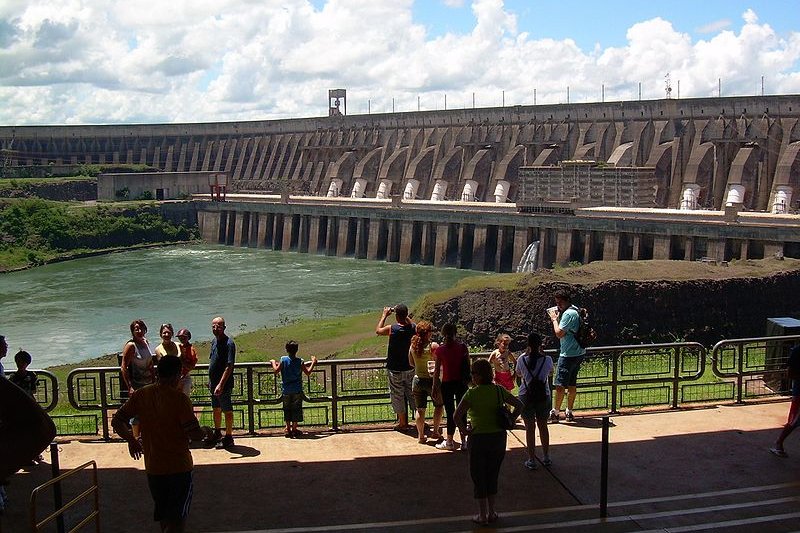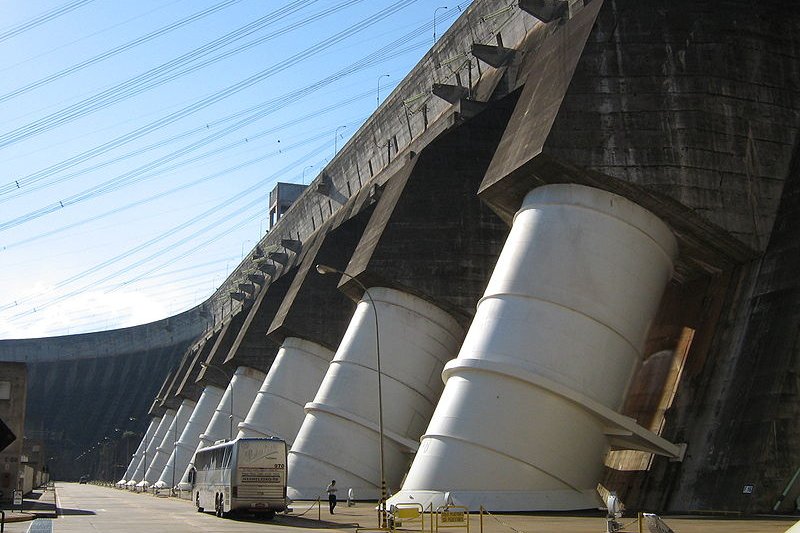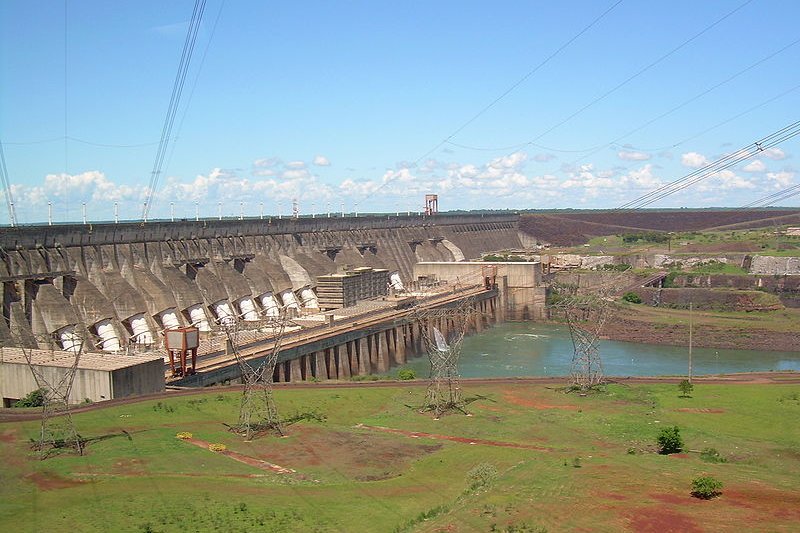 Itaipu Dam
Itaipu Dam https://commons.wikimedia.org/wiki/File:Itaipu_180.jpg
https://commons.wikimedia.org/wiki/File:Itaipu_180.jpg Herr stahlhoefer
Herr stahlhoefer
The Itaipu Dam is one of the largest hydroelectric dams in the world. It straddles the borders of Brazil and Paraguay on the Paraná River. It is able to supply 93% of the energy consumed by Paraguay and 20% of that consumed by Brazil, as of 2005. The dam is located in the vicinity of Iguazu Falls, which straddles the border of Brazil and Argentina.
The idea to build a dam across the Paraná River started in the 1960s. In 1970, a consortium formed by US-based IECO and Italian firm ELC won the competition to do a viability study for the construction of the dam.
 Base of the Itaipu Dam
Base of the Itaipu Dam https://commons.wikimedia.org/wiki/File:Itaip%C3%BA_-_tubes.jpg
https://commons.wikimedia.org/wiki/File:Itaip%C3%BA_-_tubes.jpg Wutzofant
Wutzofant
On 26 April, 1973, Brazil and Paraguay signed the Itaipu Treaty which governs how the hydroelectric potential of the Paraná River can be exploited by the two countries. Work on Itaipu Dam started in January, 1975. To create a dry section for the dam to be built, the Paraná River was diverted in 14 October, 1978.
The dam works were completed and the side canal gates closed on 13 October, 1982. This allowed the dam's reservoir to form. Due to heavy rain at that time, the water level quickly rose 100m (330ft) and reached the gates of the spillway at 10:00am, 27 October.
 Itaipu Dam
Itaipu Dam https://commons.wikimedia.org/wiki/File:Itaipu_194.jpg
https://commons.wikimedia.org/wiki/File:Itaipu_194.jpg Herr stahlhoefer
Herr stahlhoefer
The first generation unit (turbine and generator) started operations on 5 May, 1984. It is the first of 18 units to be installed, two or three per year, with the last two starting operations in 1991. Unit 19 and 20 began operations in September 2006 and March 2007 respectively. This raised the capacity to 14,000 MW.
With the installation of these two final units, the Itaipu Dam can have 18 generation units running at any one time, while two are turned off for maintenance. Also, as part of a treaty signed among Brazil, Paraguay and Argentina, no more than 18 generation units can be in operation at any one time. In comparison, all the water from nearby Iguazu Falls can feed only two generation units.
 Itaipu Dam as seen from above
Itaipu Dam as seen from above https://commons.wikimedia.org/wiki/File:Itaipu_189.jpg
https://commons.wikimedia.org/wiki/File:Itaipu_189.jpg Herr stahlhoefer
Herr stahlhoefer
The amount of concrete used to build Itaipu Dam is enough to build 210 football stadiums the size of Estadio do Maracana. The iron and steel used can build 380 Eiffel Towers. The maximum flow of Itaipu's spillway is 62.2 thousand cubic metres per second, equivalent to 40 times the amount flowing off Iguazu Falls - the flow of two generators alone is equivalent to the average flow of the falls.
Itaipu Dam is 196 m high, equivalent to a 65-storey building. The reservoir that forms behind Itaipu Dam is only the seventh largest in Brazil, behind those of Sobradinho, Tucuruí, Porto Primavera, Balbina, Serra da Mesa and Furnas dams, but it has the best relation between production and flooded area.
 Latest updates on Penang Travel Tips
Latest updates on Penang Travel Tips
 Discover with Timothy YouTube Channel
Discover with Timothy YouTube Channel
 PG Food Channel
PG Food Channel
 Learn Penang Hokkien YouTube Channel
Learn Penang Hokkien YouTube Channel
 SojiMart Videos
SojiMart Videos
Latest from Discover with Timothy: Gurney Bay - what to see and do there
About this website

Hello and thanks for reading this page. My name is Timothy and my hobby is in describing places so that I can share the information with the general public. My website has become the go to site for a lot of people including students, teachers, journalists, etc. whenever they seek information on places, particularly those in Malaysia and Singapore. I have been doing this since 5 January 2003, for over twenty years already. You can read about me at Discover Timothy. By now I have compiled information on thousands of places, mostly in Peninsular Malaysia and Singapore, and I continue to add more almost every day. My goal is to describe every street in every town in Malaysia and Singapore.
Robbie's Roadmap
- Episode 1: Robbie's Journey to Financial Freedom
- Episode 2: Lost in America
- Episode 3: The Value of Money
- Episode 4: The Mentor
- Episode 5: The Thing that Makes Money
- Episode 6: The walk with a Billionaire
- Episode 7: The Financial Freedom Awakening
- Episode 8: Meet Mr Washington
- Episode 9: The Pizzeria Incident
Copyright © 2003-2024 Timothy Tye. All Rights Reserved.


 Go Back
Go Back